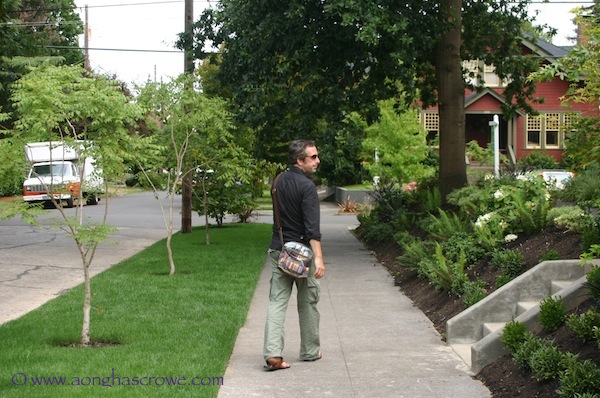Write in the T'ick of T'ings
 Wednesday, January 23, 2013 at 11:42PM
Wednesday, January 23, 2013 at 11:42PM
 Around the end of November I traveled to Kyôto to take part in the Japan Writer’s Conference, a yearly gathering of writers living and working in Japan which was held this year at Dôshisha Women’s College. Presentations were made by a number of writers on topics ranging from how to use social networking sites to sell your stuff to how to incorporate Japanese poetry into your prose or something like that.
Around the end of November I traveled to Kyôto to take part in the Japan Writer’s Conference, a yearly gathering of writers living and working in Japan which was held this year at Dôshisha Women’s College. Presentations were made by a number of writers on topics ranging from how to use social networking sites to sell your stuff to how to incorporate Japanese poetry into your prose or something like that.
I attended three presentations on a dreary Sunday morning, one of which was one on using social networking, mainly Twitter. The other two presentations were by a middle-aged American woman who writes about raising special needs bi-cultural children—talk about niches—and a representative from Tôkyô Notice Board who was seeking submissions for the free paper.
While I am glad I took part in the conference and will most likely attend the conference again next year, I only brought home two omiyage (souvenirs), if you will from the events I attended: one, writers are a terribly shabby crowd of people—with fashion sense and hygiene issues worse than university professors, which is saying a lot—and, two, the people making the presentations appeared to be as unskilled at navigating the waters of the publishing industry as me, or worse.
Take the first presentation given by the American woman. Although I learned about quite a few Internet sites that I had never heard of but which will surely come in handy, I came to the disappointing deduction that she wasn’t selling many books. She rattled of two or three examples where action had she had taken had led to a book sale, such as how commenting on another person’s blog. This kind of baby-step retailing just won’t get me to where I want to go, which is to be able to support my family comfortably on the merit of my writing alone. No mean feat.
The second presentation was more entertaining because the Englishman giving it, an author of many ebooks written in the manner of Arthur Conan Doyle, was such a conceited buffoon. I didn’t learn much from him, either. But, I did confirm that in my own gropingly blind way, I was still leagues ahead of him. The writer did give a good presentation, I must admit, far more entertaining than I ever could. I got the impression, though, that the guy went around giving the same speech as a way to promote his work. Nothing wrong with that, I suppose. But, as the American above noted correctly, writers aren’t very interested in buying other people’s books. I, too, gave a presentation to the local JALT chapter last spring, something that caused me a lot of stress and resulted in very few books being sold. I was paid ¥10,000 for the presentation, though, which is more than any of the speakers at the conference could say.
After three presentations, my brain was full, so I went out into the wet and blustery afternoon to try and get some sightseeing in before I had to catch my train home.
Across from Dôshisha’s campus, is Kyôto Gyoen, a large park in the center of Kyôto where Kyôto Gosho, the former Imperial Palace, is located. While walking around the park, I happened to bump into a Canadian who I had chatted with at the conference. He had read an excerpt from Kurt Vonnegut’s Slaughterhouse 5 at a party the night before, and I told him that I was a big fan of the author. After talking about Vonnegut, we started walking away from the park towards the south. I was making my way to the station—a walk that would take about four hours—and he was trying to get to the Kyôto National Museum before it closed.
One thing I do not like about Kyôto is how early everything closes. The museum, for one, does not allow visitors in after five-thirty, and the famous Sanjûsan Gendô temple across the street is closed to visitors in the winter months from three-thirty in the afternoon. Restaurants, too, tend to stop serving around nine in the evening. For someone used to having dinner at ten—my neighborhood of Daimyô can be very accommodating in this regard—I couldn’t believe it the first time I visited the ancient capital. You’d think that a city which is Japan’s number one or two tourist destination for foreigners and Japanese alike would be more . . . welcoming. But, no.
As the Canadian and I walked south along the Kamo River, I talked about my dreams, no my goals, with regard to writing. (I hope to, no I will be able to retire from teaching altogether within five years time and focus solely on writing, earning double what I currently make. Again, no mean feat.) The Canadian told me that he had spoken the other day to the writer of the Sherlock Holme’s fan fiction and asked him how many books he had sold.
This character, you must understand, is terribly aggressive in “marketing” (if you can call it that) his work. He posts almost daily about his books at various Facebook pages—something I’m sure that I am not alone I, finding annoying—as well as on Twitter. Because he, too, writes in such a targeted niche, his books tend to rank up rather high among Sherlock Holme’s style ebooks. (Big deal!)[1]
The English writer told the Canadian he had sold more than four thousand books. That may sound like a lot, but it doesn’t really amount to all that much in royalties. Amazon pays 35% or 70% in royalties for works published on the Kindle, much higher than traditional book publishers, which only pay 10-15%. Most of his ebooks sell for about $3.40, meaning he has earned at most $9,000 for his dozen works. Moral of this story: keep your day job.
I told the Canadian that I, too, had “sold” several thousand books over the past twelve months.[2] (A gasp of “wow” again.) But added that I was nowhere near where I wanted to be sales-wise. I wouldn’t be even begin to pay off my bar tabs with my current royalty income. (First t’ings first!)
There was another thing that the Englishman said that caused me to laugh under my breath. He boasted, yes boasted, that after signing up with a Twitter managing service, he had boosted his followers to four thousand. He paused after saying this to let his audience soak in their bedazzlement. My Gabo tweets already have over ninety thousand followers. This is nothing for me to boast about, though: the content is all Gabriel García Márquez’s.
What else did I learn from that conference? That magazines are ravenous, yet terribly picky, eaters. A problem, however, arises when you serve them a good meal. They may be more than happy to consume it, but not as eager to pay for it. I should mention that the guy who was seeking submissions for Tokyo Notice Board, a small magazine that is probably going to close up shop this year, was impressed that I had written for the “illustrious” Metropolis.
Anyways, now that my spring break has begun in earnest, I’m spending about an hour a day researching publishers and agents in the hope that I’ll find one that will help me publish and promote my novels. This is, after all, the time-honored way to make a proper living writing fiction. Everything else is fantasy.
[1] That reminds me: the woman who writes on the topic of raising a multi-cultural special needs child mentioned that her book had ranked among the top one hundred books on Japan. Some of the people in the audience gasped, “Wow!” Not to blow my own horn, but books by yours truly have been ranked so many times in the top ten such books I’ve lost count. I even had three books in the top five once, which made me awfully happy for a day or two.
[2] If you sign up for Amazon’s library which allows members to “borrow” ebooks, you get a share of the funds set aside for the library. Signing up for the library also allows you to promote your books for free, if you like. I tend to do these kinds of promos with my B-Sides essay collections as those were published more or less to attract attention to my two novels Rokuban—No. 6 and A Woman’s Nails. One of the things you’ll hear and read about the marketing side of publishing is that there is no better way to promote your work than by publishing something else. It’s true.
